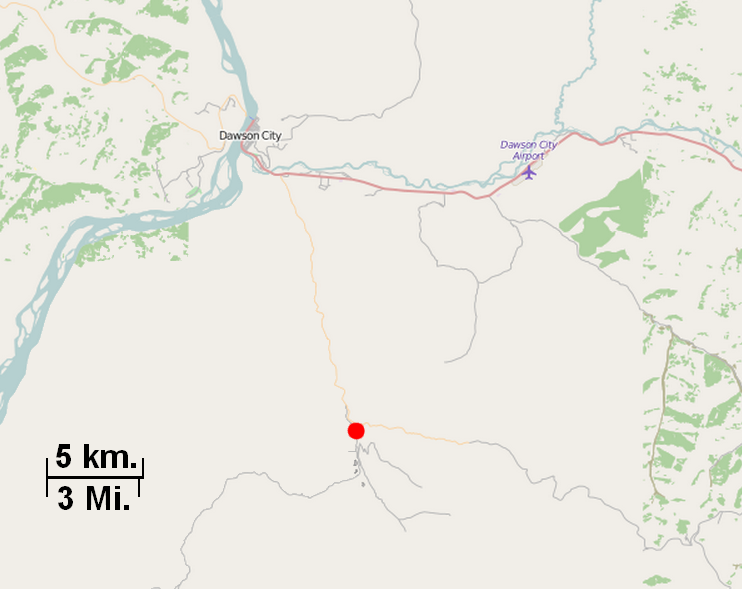Discovery Claim on:
[Wikipedia]
[Google]
[Amazon]


 Discovery Claim is a
Discovery Claim is a
File:George Carmack - 01.jpg, George Carmack, who claimed the discovery
File:Shaaw Tláa.jpg,


 Discovery Claim is a
Discovery Claim is a mining claim
Mineral rights are property rights to exploit an area for the minerals it harbors. Mineral rights can be separate from property ownership (see Split estate). Mineral rights can refer to sedentary minerals that do not move below the Earth's surfac ...
at Bonanza Creek
Bonanza Creek (Hän: ''Ch'ö`chozhù' ndek'') is a watercourse in Yukon Territory, Canada. It runs for about from King Solomon's Dome to the Klondike River. In the last years of the 19th century and the early 20th century, Bonanza Creek was the c ...
, a watercourse
A stream is a continuous body of surface water flowing within the bed and banks of a channel. Depending on its location or certain characteristics, a stream may be referred to by a variety of local or regional names. Long large streams a ...
in the Yukon
Yukon (; ; formerly called Yukon Territory and also referred to as the Yukon) is the smallest and westernmost of Canada's three territories. It also is the second-least populated province or territory in Canada, with a population of 43,964 as ...
, Canada. It is the site where, in the afternoon of August 16, 1896, the first piece of gold was found in the Yukon by prospectors. The site is considered to be the place where the Klondike gold rush started. It is located around 17 km south-southeast of Dawson City
Dawson City, officially the City of Dawson, is a town in the Canadian territory of Yukon. It is inseparably linked to the Klondike Gold Rush (1896–99). Its population was 1,577 as of the 2021 census, making it the second-largest town in Yuko ...
. The Discovery claim was designated a National Historic Site of Canada
National Historic Sites of Canada (french: Lieux historiques nationaux du Canada) are places that have been designated by the federal Minister of the Environment on the advice of the Historic Sites and Monuments Board of Canada (HSMBC), as being ...
on July 13, 1998.
Discovery
On August 16, 1896 George Carmack, an American prospector, hisTagish
The Tagish or Tagish Khwáan ( Tagish: ; tli, Taagish ḵwáan) are a First Nations people of the Athabaskan-speaking ethnolinguistic group that lived around Tagish Lake and Marsh Lake, in Yukon of Canada. The Tagish intermarried heavily with ...
wife Kate Kate name may refer to:
People and fictional characters
* Kate (given name), a list of people and fictional characters with the given name or nickname
* Gyula Káté (born 1982), Hungarian amateur boxer
* Lauren Kate (born 1981), American autho ...
(birthname Shaaw Tláa), her brother Skookum Jim (birthname Keish), and their nephew Dawson Charlie (K̲áa Goox̱), while travelling through the area, stopped to rest on the banks of one of the Klondike River
The Klondike River (Hän: ') is a tributary of the Yukon River in Canada that gave its name to the Klondike Gold Rush. The Klondike River rises in the Ogilvie Mountains and flows into the Yukon River at Dawson City.
Its name comes from the HĂ ...
's tributaries called Bonanza Creek, then called Rabbit Creek. They were there on the a suggestion of another prospector Robert Henderson. One of them noticed a shiny object in the water. It was gold and Carmack took credit for finding it. It is uncertain whether it was George Carmack, Kate Carmack or Skookum Jim who made the discovery, but the group decided that George Carmack be named as the official discoverer out of concern that mining authorities would be reluctant to recognize a claim made by an Indigenous claimant.
Staking
On August 17, 1896, they staked out four claims, the first at Bonanza Creek. Two were for George Carmack. At that time, being the first to discover gold in an area entitled him to stake another, second claim. The other two claims were staked on behalf of Skookum Jim and Dawson Charlie.Kate Carmack
Shaaw Tláa, also known as Kate Carmack ( – 29 March 1920), was a Tagish First Nation woman who was one of the party that first found gold in the Klondike River in 1896, and is sometimes credited with being the person who made the actual ...
, his wife, wearing her famous gold nugget necklace, 1898
File:Skookum Jim Mason.png, Skookum Jim, one of the discoverers, 1898
File:Dawson Charlie aka K̲áa Goox̱ - 01.jpg, Dawson Charlie
Registration
The following month on September 24 they registered the claims. This took place at the police post in Forty Mile 80 km away at the mouth of the Forty Mile River. The initial claim is described legally as Claim 37903, a 152.4 metre (500 ft.) by 609.6 metre (2,000 ft.) area.Notes
References
Bibliography
* *External links
{{coord, 63.9168, N, 139.317, W, type:landmark, display=title Klondike Gold Rush National Historic Sites in Yukon Gold mining in Yukon 1890s in Yukon